CORVIDAE
The Corvidae family contains the crows, ravens, rooks, jackdaws, jays, magpies, treepies, choughs and nutcrackers. These species are grouped into subfamilies that are outlined in the table that follows. Beware that names such as jays, magpies, or treepies are not always assigned in a consistant manner. For example, the black magpie (Platysmurus leucopterus) belongs to the treepie subfamily.
| SUBFAMILY | MEMBERS |
| Corvinae | True crows of genus Corvus includes the crows, ravens, rooks, jackdaws. |
| Corvinae (continued) | Jays of genus Garrulus, nutcrackers of Nucifraga, magpies of Pica, ground-jays of Jay Podoces, and the piapiac of Ptilostomus, and Stresemann's bush-crow of Zavattariornis. |
| Cissinae | Green-magpies of Cissa and the blue-magpies of Urocissa. |
| Cyanocoracinae | Most of the species that are named "jay". |
| Crypsirininae | Treepies |
| Perisoreinae | Three jay species of Perisoreus and Magpies of Cyanopica |
Subfamily Cyanocoracinae - New World Jays
Thirty two to the 38 New World species are found in Mexico, Central America, and South America. The New World jays are mostly between 25 and 40 cm; some of the that length is due to their long tails. The smallest of is the dwarf jay which is 20 to 23 cm long and only weighs about 40 grams.
The magpie-jays are up to 75 cm long and have the longest tails of the jays. Almost all jays have some blue on them, and for many species blue is the predominant color. In fact, cyan in the subfamilies name refers to the color blue. The only New World jay that is completely lacking in blue is the brown jay. The jays are vocal and able to produce a variety of sounds and some even mimic sounds. A loud hash calls is used to warn about intruders.
The New World jays are found in scrubland, pine-oak forests, other forest types as long as they are not very dense and have open areas, forest edges, and wooded savannas. They have heavy stout bill which helps to enable them to be omnivores. Some species have a more plant based diet while others are more animal focused. Insects, seeds, fruit and berries are on most diets. Caterpillars, frogs, lizards, eggs and nestlings of other birds are also commonly eaten by the New World jays.
Because of their varied diet, the jays' populations on the whole are doing well, most of their conservations status are listed as Least Concern. Those with declining population are in trouble due to their environment being degraded via human changes. Deforestation, as with bird species world wide, is the major cause. Expanding human populations need to do more to preserve avian habitats. This is especially a challenge when a bird species is found a limited range. In addition to deforestation, global warming plus human interference with natural but small fires, is causing forest to burn with much larger and hotter fires than normal. This too is detrimental to jays in particular, and birds in general.
The nests are cup-shaped, made from twigs and lined with softer plant material. Most of the species are cooperative breeders. Usually the female is the sole incubator. The incubation period is about 2 plus weeks and the time to fledge is a little longer. The male and helpers provide her and the chicks with food. Sometimes the helper's food is provided directly to the chicks, and other times the food is given to the female parent which then gives it to the chicks. In addition to helping to provide for the chicks, helpers contribute to defending the young from predators. The helpers are younger birds who benefit not only to helping the species survive, but also learn parenting responsibilities.
In addition to these New World jays, there are Old World jays of genus Garrulus which belong to the Corvidae subfamily Covinae. They are mainly found in Europe and Asia, with the Eurasian jay also found in northern Africa. There are only 3 species of Garrulus jays, but the Eurasian jay has almost 30 subspecies, many of which are very distinct. The jays in this genus are similar to the New World jays, both in appearance and behavior. They are colorful and have a large head, robust bill, solid body, plus relatively long tail. They are omnivores eating insects, spiders, lizards, eggs, chicks, nuts, seeds, grains, and fruit. The nests are cup shaped with a base of twigs and lined with softer plant material. It is constructed by both sexes, but onlty the female incubates.
Another type of jar are the ground-jays of genus Podoces. They look and behave differently form the Garrulus jays and also the New World jays. Because they pursue much of their prey on the ground, they have strong legs designed for fast runnin;g and their long, curved thick bills are adapted for digging and probing. Their nests are built in bushes, usually less than 2 meters from the ground. This is not surprising since they are poor fliers and would not want to waste energy flying high into a tree to feed their chicks. The ground-jays inhabit high altitude semi-desert areas from central Asia to Mongolia.
Genus Aphelocoma
These 7 jay species live in scrub forests, open pine-oak forests, chaparral, and mixed evergreen forests. They have mainly blue upperparts, a stout black bill, and pale grey underparts (except for the unicolor jay which has blue underparts). They have no crest. They are found in Mexico, western United States, and western Central America. Also, the Florida scrub-jay is found in Florida. They hide food in caches and can remember over 100 such sites. They nest low in trees or in bushes. Most are cooperative breeders; the younger birds stay part of the family unit for a couple of years during which time they help feed the young and protect against predators such as hawks. Only the female parent incubates the eggs.
Jay,_California_Scrub- Aphelocoma californica
Range: Western North America, relatively close to the coast.
Habitat: Low scrub, preferring pinon-juniper forests, oak woods, and edges of mixed evergreen forests. It also inhabits suburban gardens.
Diet: Small animals such as frogs and lizards, eggs and young of other birds, insects, grains, nuts, and berries. They have a good spatial memory and will cash food such as acorns.
Conservation status: Least Concern.
1) Juvenile




Jay,_Florida Scrub- Aphelocoma coerulescens
Range: Florida.
Habitat: Scrub habitat which is characterized by nutrient-poor soil, occasional drought, and frequent wildfires.
Diet: Acorns, seeds, peanuts, insects, tree-frogs, turtles, snakes, lizards, and young mice.
Conservation status: The Florida scrub-jay is listed as Vulnerable because fire suppression has caused scrubland to transform into larger trees such as oaks.



Jay,_Island_Scrub- Aphelocoma insularis
Range: Santa Cruz Island, California.
Habitat: Oak chaparral and bishop pine.
Diet: Mainly acorns, especially in the fall. Also, small animals such as frogs and lizards, eggs and young of other birds, insects, grains, and berries.
Conservation status: The island scrub-jay is listed as Vulnerable because more intense than normal fires are changing their environment.



Jay,_Mexican Aphelocoma wollweberi Found: North America
Range: Northern Mexico and southwestern USA.
Habitat: Pine-oak forest.
Diet: Mainly acorns and pine nuts. Also a a wide variety of plant and animal matter.
Conservation status: Least Concern.
1) Juvenile

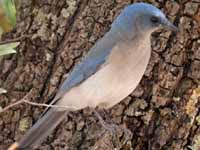


Jay,_Transvolcanic Aphelocoma ultramarina
Range: A relatively narrow belt which has some active volcanoes in central Mexico.
Habitat: Montane pine-oak forests.
Diet: Nuts, pine seeds, insects, fruit.
Conservation status: Least Concern.


Jay,_Unicolor Aphelocoma unicolor
Range: Mexico, Central America.
Habitat: Cloud forests, pine-oak forests.
Diet: Large insects, small vertebrates, seeds, fruit.
Conservation status: Least Concern.



Jay,_Woodhouse's_Scrub- Aphelocoma woodhouseii
Range: Southeastern Oregon to central Mexico.
Habitat: Areas of low scrub, preferring pinon-juniper forests.
Diet: Seeds, nuts, insects, spiders.
Conservation status: Least Concern.



Genus Calocitta
The two mappie-jay species both have black sparce crests. They live in Mexico and Central America.
Jay,_Black-throated Magpie- Calocitta colliei
Range: Mexico.
Habitat: Open forests, bushy areas.
Diet: An omnivore preferring invertebrates and fruit.
Conservation status: Least Concern.



Jay,_White-throated_Magpie- Calocitta formosa
Range: Mexico, Central America.
Habitat: A variety of forests.
Diet: Insects and caterpillars, frogs, lizards, eggs and nestlings of other birds, seeds, fruits, grain.
Conservation status: Least Concern.




Genus Cyanocitta
This genus contains the Blue jay and Steller's jay which are both North American crested jays.
Jay,_Blue Cyanocitta cristata
Range: North America, but not the far west.
Habitat: Various from the pine woods of Florida to the spruce-fir forests of northern Ontario.
Diet: Insects, nuts, seeds, fruit, eggs.
Conservation status: Least Concern.




Jay,_Steller's Cyanocitta stelleri
Range: Western North America.
Habitat: Forests.
Diet: About two-thirds plant matter and one-third animal matter. Included are nuts, seeds, berries, insects, small rodents, eggs, chicks.
Conservation status: Least Concern.




Genus Cyanocorax
This genus contains 16 closely related species that primarily are found in wooded habitats of Mexico, Central America, and South America, with the Green jay just barely entering the United States. The upperparts (except for the Green jay) are primarily blue or purplish. They all have a black bib and all have some black on their head.
Jay,_Azure Cyanocorax caeruleus
Range: Mainly southeast Brazil; also northeast Argentina, eastern Paraguay.
Habitat: Evergreen forests, especially those of the Araucaria tree.
Diet: Nut-like seeds of the Araucaria tree; also insects, fruit.
Conservation status: The azure jay is listed as Near Threatened as the population seems to be declining due to deforestation.



Jay,_Azure-naped Cyanocorax heilprini
Range: Brazil, Columbia, Venezuela.
Habitat: Stunted forests, forest edges and second growth on sandy soils.
Diet: Invertebrates such as insects, seeds, fruit.
Conservation status: Least Concern.
Image by: 1) Joao_Quental 2) Anthony_Kaduck - Columbia 3) Nick Athanas - Columbia


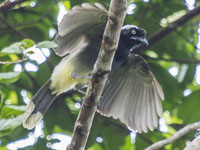
Jay,_Black-chested Cyanocorax affinis
Range: Costa Rica, Panama, Columbia, Venezuela.
Habitat: Lowland forests and degraded forests.
Diet: Fruits, berries. Also invertebrates such as insects.
Conservation status: Least Concern.




Jay,_Bushy-crested Cyanocorax melanocyaneus
Range: El Salvador, Guatemala, Honduras, and Nicaragua.
.
Habitat: Forest, usually pine and oak, with open areas. Also degraded forests including coffee plantations.
Diet: Nuts, seeds, fruit, insects and other invertebrates.
Conservation status: Least Concern.


Jay,_Cayenne Cyanocorax cayanus
Range: Northern Brazil, the Guianas, eastern Venezuela.
Habitat: Forest edges and clearings, wooded savannas.
Diet: Insects such as beetles, grasshoppers. Also fruit.
Conservation status: Least Concern.


Jay,_Curl-crested Cyanocorax cristatellus Found: South America
Range: Mainly Brazil; also east Bolivia and northeast Paraguay.
Habitat: Savanna, scrubland, thorny brush.
Diet: Almost anything: nuts, seeds, fruit, insects, eggs, chicks, etc.
Conservation status: Least Concern.

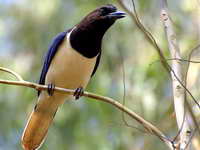

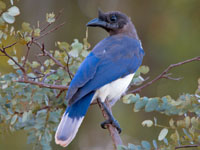
Jay,_Green Cyanocorax yncas
Range: South Texas to Honduras and the Andes of South America.
Habitat: Open woodland, shrubland.
Diet: Insects, seeds, fruit.
Conservation status: Least Concern.




Jay,_Plush-crested Cyanocorax chrysops Found: South America
Range: Central-southern South America.
Habitat: Varied form forests to scrub and groves of trees.
Diet: Insects, seeds, nuts, fruit.
Conservation status: Least Concern.




Jay,_Purplish Cyanocorax cyanomelas
Range: Nnorthern Argentina, Bolivia, southern Brazil, Paraguay and southeastern Peru.
Habitat: Wooded area and scrubland, but not heavily forested areas.
Diet: Insects such as grasshoppers and beetles; fruit, seeds, and crops such as corn.
Conservation status: Least Concern.
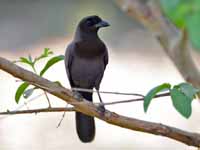

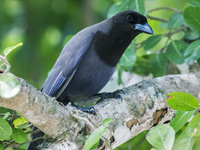

Jay,_Purplish-backed Cyanocorax beecheii
Range: Northwestern Mexico.
Habitat: Dry deciduous forests, scrubland.
Diet: Small animals, both invertebrates and vertebrates, such as termites, beetles, lizards, and small rodents. Their prey may be caught in the air, on leaves, or on the ground. They also eat grain, seeds and fruit.
Conservation status: Least Concern.




Jay,_San Blas Cyanocorax sanblasianus
Range: Central-western Mexico.
Habitat: Varied including forests and their edges, scrubby woodland, plantations.
Diet: Insects including beetles and cockroaches, lizards.
Conservation status: Least Concern.


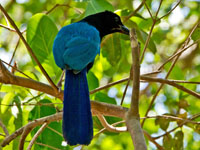
Jay,_Tufted Cyanocorax dickeyi
Range: West-central Mexico in a small area of the Sierra Madre Occidental of Sinaloa and Durango.
Habitat: Pine-oak woodlands and other deciduous forests.
Diet: Acorns, fruit. Also insects.
Conservation status: The tufted jay is listed as Near Threatened because of its limited range and habit loss. The population is between 10,000 and 20,000.
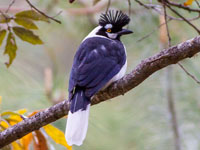



Jay,_Violaceous Cyanocorax violaceus Found: South America
Range: Northern South America.
Habitat: Tropical evergreen rainforest. Usually found in the midle and upper levels.
Diet: Omnivorous, mainly consuming fruits, insects, plus bird and reptile eggs.
Conservation status: Least Concern.

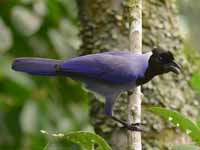

Jay,_White-naped Cyanocorax cyanopogon
Range: Brazil.
Habitat: Dry forest, forest edge, and near streams.
Diet: Insects, spiders, fruit, seeds.
Conservation status: Least Concern.




Jay,_White-tailed Cyanocorax mystacalis
Range: Ecuador and Peru.
Habitat: Various types of woodlands. Favors mesquite or woods near moving water.
Diet: Seeds, insects such as beetles and ants. Will take eggs, even from domestic sources.
Conservation status: Least Concern.
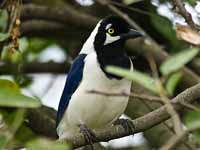



Jay,_Yucatan Cyanocorax yucatanicus
Range: Belize, Guatemala, Mexico.
Habitat: Most types of forest and also coastal scrub.
Diet: Seeds (especially corn), insects such as beetles, and other items as the opportunity presents.
Conservation status: Least Concern.




Genus Cyanolyca
These 9 species are mainly blue and have a black mask. They also possess black bills and legs and are skulking birds. They are found in Mexico, Central America and northwestern South America.
Jay,_Azure-hooded Cyanolyca cucullata
Range: Mexico, Central America.
Habitat: Evergreen forests and forest edges.
Diet: Insects, spiders, fruit.
Conservation status: Least Concern.




Jay,_Beautiful Cyanolyca pulchra
Range: Columbia, Ecuador.
Habitat: Humid montane forest, cloud forests, secondary forests, and clearings.
Diet: Probably similar to the azure-hooded jay: insects, spiders, fruit.
Conservation status: The beautiful jay is listed as Near Threatened because it has a limited range and it prefers a primary forest habitat.



Jay,_Black-collared Cyanolyca armillata
Range: The Andes of Columbia, Ecuador, and Venezuela.
Habitat: Cloud forest and forest edges.
Diet: Information needed.
Conservation status: Least Concern.



Jay,_Black-throated Cyanolyca pumilo
Range: Southeast Mexico to Honduras.
Habitat: Moist montane forests.
Diet: Like most jays, it is probably omnivorous.
Conservation status: Least Concern.


Jay,_Dwarf Cyanolyca nanus
Range: Although it can be locally common, this jay has a small distribution in the mountains of southeastern Mexico.
Habitat: Montane forests, specifically comprising an oak-pine mix.
Diet: Mainly insects such as beetles and flies.
Conservation status: The dwarf jay is listed as Near Threatened because of its limited range and their prefered habitiat is being destroyed. That said, there is no evidence that their population is declining.


Jay,_Silvery-throated Cyanolyca argentigula
Range: Costa Rica, Panama.
Habitat: Montane forests and their edges.
Diet: Insects, acorns, fruit.
Conservation status: Least Concern.

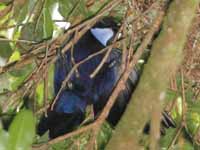
Jay,_Turquoise Cyanolyca turcosa
Range: Columbia, Ecuador, Peru.
Habitat: Thick forests.
Diet: Insects, berries, fruit, eggs, chicks.
Conservation status: Least Concern.
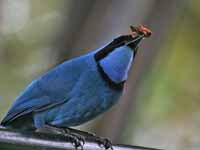



Jay,_White-collared Cyanolyca viridicyanus
Range: Bolivia, Peru
Habitat: Humid montane forests from 2000 to 3000 meters, and the edges of these forests.
Diet: Information needed.
Conservation status: The white-collared jay is listed as Near Threatened because it is not often encountered so it assumed to have a small population.
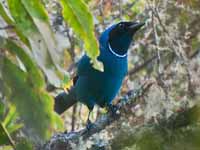


Jay,_White-throated Cyanolyca mirabilis
Range: South-western Mexico.
Habitat: Humid forests, both pine-oak and evergreen.
Diet: Information needed.
Conservation status: It is listed as Vulnerable because it is found in a limited range and there is concern that the population is declining.
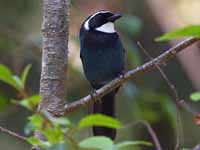

Genus Gymnorhinus - 1 species
Jay,_Pinyon Gymnorhinus cyanocephalus
Range: Western North America.
Habitat: Pinyonh-juniper woodlands and ponderosa pine forests
Diet: The seeds of the pinyon pine is their favorite food. Also fruits, insects.
Conservation status: It is listed as Vulnerable because its habitat is being used for charcol production and mining.
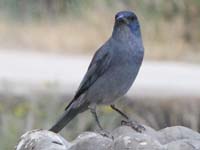



Genus Psilorhinus - 1 species
Jay,_Brown Psilorhinus morio
Range: Southern Texas to Panama.
Habitat: Lowland forests that are not dense; also forest edges and clearings.
Diet: Insects, other invertebrates, lizards, fruit. Eggs and chicks when food is scarce.
Conservation status: Least Concern.
1) Juvenile




Genus Platylophus - 1 species
The crested jay is traditionally placed in the family Corvidae but might belong to the helmetshrikes of family Prionopidae or perhaps even its own family. It is not part of the jay subfamily Cyanocoracinae.
Jay,_Crested Platylophus galericulatus
Range: Southeast Asia, Indonesia, Malaysia.
Habitat: Broadleaf forests.
Diet: Caterpillars, grasshoppers, beetles, wasps.
Conservation status: The crested jay is listed as Near Threatened because forest destruction has lead to a declining population.


